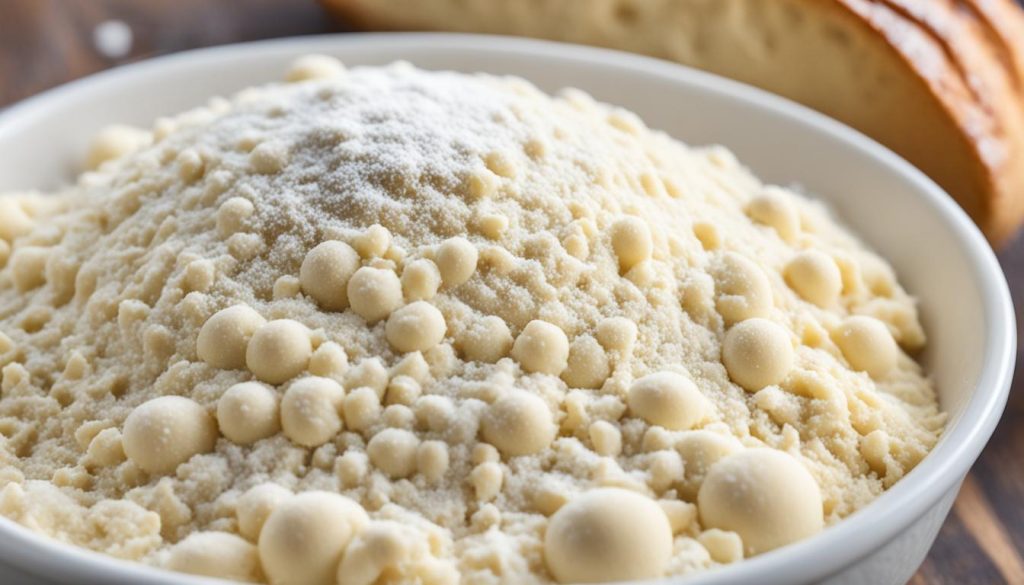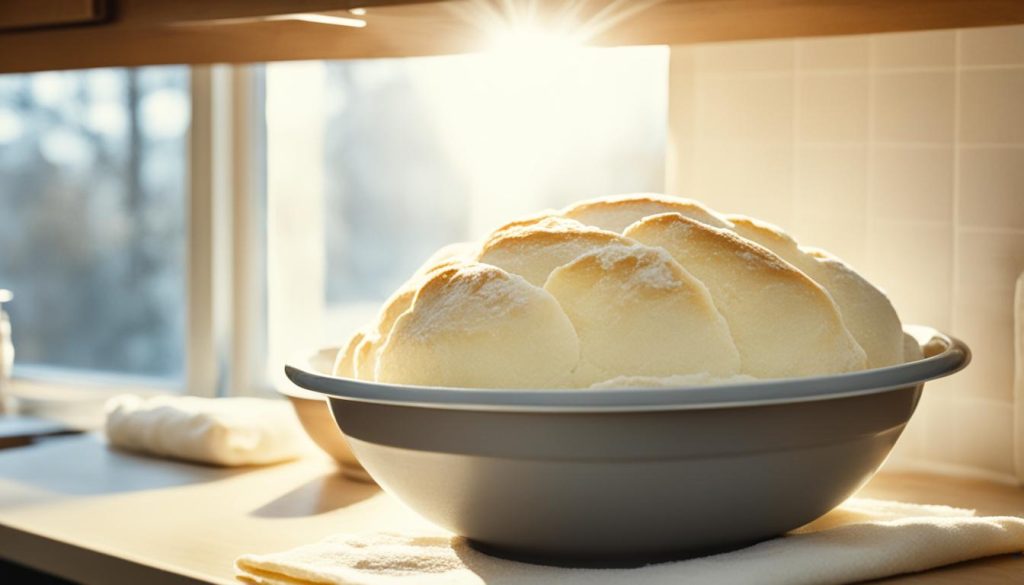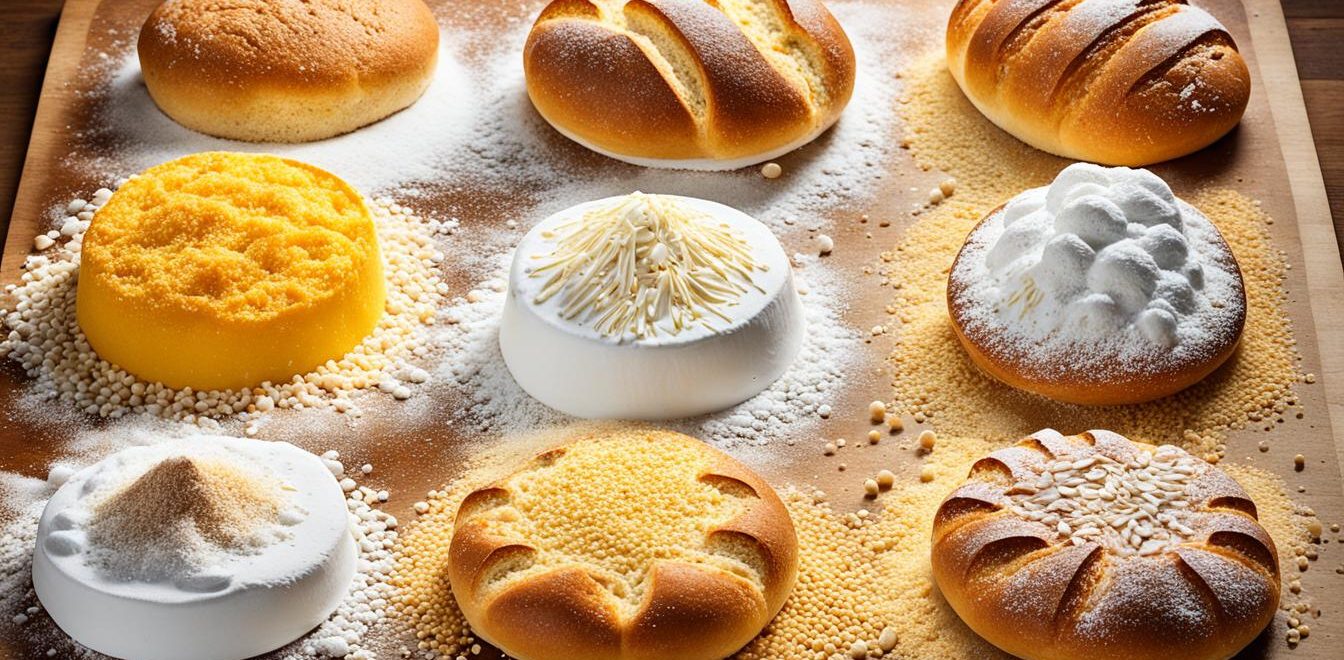Table of Contents
Have you ever wondered why your cakes sometimes turn out dense and flat, while other times they rise perfectly with a soft and airy texture? Or why some cookies come out chewy and gooey, while others are crispy and brittle? The secret behind achieving baking perfection lies in understanding the science behind it. From the chemistry of ingredients to the impact of temperature, there are fascinating principles at play that can help you become a baking expert. So, what exactly is the science behind baking? Let’s delve into the world of baking science, where we’ll uncover the secrets of baking chemistry, explore the role of food science in creating delicious treats, and discover the techniques and innovations that make baking both an art and a science.
Whether you’re a seasoned baker or just starting out, understanding the science of baking can transform your passion into a mastery. Get ready to unlock the secrets of baking science and take your baking skills to the next level!
What is food chemistry and why is it important in baking
Food chemistry forms the very foundation of successful baking. It encompasses the understanding of how individual ingredients harmoniously work together to create a final delectable product. By grasping the principles of food chemistry, you can unlock the secrets behind perfect cakes, cookies, and bread. The magic of chemical reactions in baking, be it the fermentation process in breadmaking where yeast produces carbon dioxide essential for dough rising, or the interaction between baking soda and acidic ingredients like buttermilk or vinegar that result in light and fluffy cakes, is at the core of achieving greatness in the art of baking.
Having a firm grasp of food chemistry empowers you to become a baking virtuoso, enabling you to fine-tune your recipes, troubleshoot issues, and tailor your creations to perfection. By understanding how ingredients and their chemical properties interact, you can achieve superior texture, flavor, and appearance in your baked goods. Food chemistry is the secret ingredient that elevates your baking to new heights, allowing you to create mouthwatering treats that will impress every palate. Embrace the power of food chemistry and unlock the full potential of your baking prowess.
Exploring the role of baking ingredients and how they interact with each other
Baking is more than just mixing ingredients together. It’s a delicate dance of chemistry, where each ingredient plays a crucial role in the final outcome. Understanding how these ingredients interact with each other is key to creating mouthwatering baked goods.
Let’s take a closer look at some of the key baking ingredients and their functions:
1. Flour
Flour is the backbone of baking. It provides structure and stability to your baked goods. The protein in flour, known as gluten, forms a network that traps air bubbles during mixing. This network gives baked goods their structure and texture. Different flours, such as all-purpose, bread, and cake flour, have varying levels of protein content, which affects the final result.
2. Sugar
Sugar does more than just sweeten your treats. It adds moisture, tenderness, and helps with browning. It also plays a crucial role in enhancing flavor. In addition to granulated sugar, other sweeteners like brown sugar, honey, and maple syrup can provide unique characteristics to your baked goods.
3. Baking Powder and Baking Soda
Baking powder and baking soda are leavening agents that create lift in your baked goods. Baking powder is a combination of an acid and a base, which react when mixed with liquids and heat, releasing carbon dioxide. This gas expands and causes the dough or batter to rise. Baking soda, on the other hand, requires an acidic ingredient in the recipe to produce the same effect. Together, these leavening agents ensure a light and airy texture in your baked treats.
When these ingredients interact, magic happens in the oven. For example, the acidity in buttermilk activates the baking soda, resulting in a fluffy cake. Understanding these interactions can help you adjust and experiment with your recipes for optimal results.
Now that you have a better understanding of the roles and interactions of baking ingredients, you can confidently venture into the world of baking chemistry and create delectable treats every time.
Examining the types of reactions that can occur when baking and how to use them to make more delicious recipes
Baking is more than just mixing ingredients together and putting them in the oven. It’s a precise dance of flavors and textures, brought to life by various chemical reactions that occur during the baking process. Understanding these reactions can unlock a world of delicious possibilities, allowing you to tailor your recipes and create unforgettable baked goods.
One of the key reactions in baking is the Maillard reaction. It occurs when heat causes amino acids and reducing sugars to combine, resulting in the desirable golden brown crust on baked goods. This reaction not only adds visual appeal but also imparts a rich, complex flavor to your creations.
Another important reaction in baking is caramelization. As sugars break down under heat, they transform into a sweet, golden syrup that brings depth and sweetness to your desserts. Caramelization can enhance the flavor of breads, cakes, and pastries, elevating them from ordinary to extraordinary.
Chemical reactions can also occur when baking soda reacts with acidic ingredients like buttermilk or vinegar. This reaction, known as the acid-base reaction, creates carbon dioxide bubbles that help your baked goods rise. It plays a crucial role in making light and airy cakes, muffins, and pancakes.
By understanding these reactions and how they contribute to flavor and texture, you can take your baking to the next level. Experiment with different temperatures, ingredient combinations, and baking times to achieve the desired results. Whether you want a perfectly browned crust, a caramelized glaze, or a light and fluffy texture, harnessing these reactions will help you create unforgettable, mouthwatering treats.
Understanding the differences between wet and dry ingredients and their effects on texture, flavor, and appearance of baked goods
In the world of baking, it’s crucial to grasp the distinctions between wet and dry ingredients. Each type plays a unique role in the creation of delectable baked treats, influencing their texture, flavor, and appearance.
Dry ingredients, such as flour and sugar, offer more than just their individual flavors. They provide the structure that supports baked goods, giving them the right crumb and texture. Flour, in particular, acts as a binding agent, holding everything together. Meanwhile, sugar not only sweetens but also adds moisture to the final product.
On the other hand, wet ingredients like eggs and milk are key players when it comes to binding everything together and contributing moisture. Eggs, with their protein content, provide structure and stability, yielding a moist and tender finished product. Milk, with its liquid component, ensures a smooth and creamy texture.
To create different textures and appearances in your baked goods, you can manipulate the proportion and combination of wet and dry ingredients. Adjusting the ratios can result in anything from light, airy cakes to dense, fudgy brownies. It’s all about finding the perfect balance for the desired outcome.
Understanding the intricate dance between wet and dry ingredients is essential for achieving baking success. By mastering this delicate interplay, you’ll be well on your way to creating mouthwatering treats that delight the palate and please the eye.
The power of yeast in bread making – what elements are needed for the perfect rise
Yeast plays a vital role in the art of bread making, transforming simple ingredients into fluffy, flavorful loaves. It is the key ingredient responsible for the dough’s rise and the creation of that desirable light and airy texture we all love. However, yeast alone cannot work its magic; it requires the perfect balance of other essential elements to achieve bread perfection.
When it comes to making bread, the type and quality of yeast you use are crucial. There are different varieties of yeast, including active dry yeast, instant yeast, and fresh yeast. Each type has its own characteristics and requires specific techniques for activation and incorporation into the dough. Experimenting with different yeast varieties can help you discover your preferred flavor and texture.
In addition to yeast, several other elements contribute to the characteristics of the final bread. Flour is the primary ingredient, serving as the backbone of the dough. The type of flour used, such as all-purpose, bread flour, or whole wheat, affects the texture and structure of the bread. The gluten content in bread flour helps create elasticity and a chewy crumb, while whole wheat flour adds a nutty flavor and dense texture.
- Water is another crucial element that interacts with the yeast and flour to foster fermentation. The temperature and quantity of water influence the rate at which yeast activates and how the dough develops. Proper hydration is essential for yeast growth and enzyme activation, resulting in a well-risen loaf.
- Sugar acts as a food source for yeast during fermentation. It not only enhances yeast activity but also contributes to the bread’s flavor and color. Common sweeteners used in bread making include granulated sugar, honey, and malt extract. Experimenting with different sugars can produce subtle variations in taste and appearance.
- Salt plays a critical role in bread making beyond its flavor-enhancing properties. It regulates yeast activity, strengthens gluten structures, and controls fermentation. Adding the right amount of salt improves the texture and extends the shelf life of the bread.
To achieve the perfect rise in bread, the interaction between these ingredients must be carefully balanced and controlled. The amount of each element, the mixing technique, and the fermentation time all influence the final texture, flavor, and aroma of the bread. Whether you prefer a soft, tender crumb or a hearty, rustic loaf, understanding the role of these elements in bread making is essential.
Experimenting with different combinations of yeast, flour, water, sugar, and salt will allow you to create a wide range of bread variations. From crusty artisan loaves to fluffy sandwich bread, the possibilities are endless. So embrace the power of yeast, explore the world of bread making, and savor the joy of baking your own delicious loaves.

Tips for creating delicious baked goods every time from Marky’s Gourmet Foods
When it comes to baking, expert advice can make all the difference in creating truly delectable treats. At Marky’s Gourmet Foods, we’ve mastered the art of baking and are excited to share some valuable tips with you. By following these tried-and-true techniques, you can elevate your baking skills and achieve exceptional results every time.
1. Use high-quality ingredients
Ingredient quality plays a crucial role in the flavor and overall quality of your baked goods. Opt for fresh, organic ingredients whenever possible, as they can greatly enhance the taste and texture of your creations. Whether it’s using pure vanilla extract or premium chocolate chips, investing in high-quality ingredients will take your baking to the next level.
2. Accurate measurements matter
In baking, precision is key. Make sure to measure your ingredients accurately using the appropriate measuring tools. A slight variation in measurements can significantly impact the final outcome of your baked goods. So, grab your measuring cups and spoons and ensure you’re following the recipes with precision.
3. Master the mixing techniques
The way you mix your ingredients can affect the texture and appearance of your baked goods. Creaming butter and sugar together creates a light and airy texture, while gently folding in dry ingredients preserves the delicate structure. Experiment with different mixing techniques and find the ones that work best for your recipes.
4. Bake with precision
Proper baking time and temperature are crucial for achieving perfect results. Invest in an oven thermometer to ensure accurate temperature readings, and always preheat your oven to the recommended temperature. Additionally, keep a close eye on your baked goods and perform the toothpick test to determine when they’re perfectly baked.
These expert tips from Marky’s Gourmet Foods will set you on the path to baking success. Remember, using high-quality ingredients, measuring accurately, mastering mixing techniques, and precise baking are the keys to creating delicious treats that will impress everyone. So, put on your apron, grab your baking tools, and let your culinary creativity shine!
The best baking science books for mastering the art of baking
Looking to expand your baking knowledge and master the art of baking? Delve into the intricacies of baking science with these recommended baking science books. These resources provide in-depth knowledge about the chemistry, techniques, and principles behind baking, allowing you to take your baking skills to the next level.
Here are some highly recommended titles:
- “How Baking Works” by Paula I. Figoni
- “Ratio: The Simple Codes Behind the Craft of Everyday Cooking” by Michael Ruhlman
- “The Flavor Bible: The Essential Guide to Culinary Creativity, Based on the Wisdom of America’s Most Imaginative Chefs” by Karen Page and Andrew Dornenburg
- “The Science of Cooking: Every Question Answered to Perfect Your Cooking” by Dr. Stuart Farrimond
- “BakeWise: The Hows and Whys of Successful Baking with Over 200 Magnificent Recipes” by Shirley O. Corriher
These baking science books offer valuable insights into the world of baking and serve as excellent references for both beginners and experienced bakers. Whether you’re interested in understanding the science behind ingredient interactions, exploring flavor combinations, or learning about precise baking techniques, these books provide the knowledge you need to enhance your baking skills and create delicious treats.
Let these baking resources be your guide as you delve deeper into the fascinating world of baking science. With the knowledge gained from these books, you’ll be equipped to experiment, innovate, and create mouthwatering baked goods that will impress friends, family, and yourself.
The role of ingredients, temperature, and mixing techniques in successful baking
To achieve successful baking results, it’s essential to understand the role of ingredients, temperature, and mixing techniques. Quality ingredients, accurate measurements, and proper temperature control contribute to the texture, flavor, and appearance of your baked goods.
The ingredients you choose play a pivotal role in baking. Each ingredient serves a specific purpose, whether it’s providing structure, adding sweetness, or enhancing moisture. For example, flour provides the necessary structure, sugar adds sweetness and moisture, and baking powder or yeast creates lift. Using high-quality ingredients ensures that your baked goods turn out delicious and satisfying.
Accurate measurements are crucial in baking. Precise quantities of ingredients can make a significant difference in the final outcome. Consider investing in a kitchen scale to ensure you measure ingredients accurately. This attention to detail will help you achieve consistent and impeccable results.
Controlling the temperature during the baking process is essential. Different baked goods require different oven temperatures, and precise temperature control is vital for achieving the desired texture and doneness. Keep in mind that oven temperatures can vary, so check the accuracy of your oven using an oven thermometer.
Mixing techniques also play a crucial role in baking. The way you combine ingredients greatly affects the final texture and appearance of your baked goods. Different mixing techniques, such as beating, creaming, folding, and kneading, create different results. Beating incorporates air and leads to a lighter texture, creaming combines butter and sugar for a fluffy and tender crumb, folding gently incorporates ingredients without deflating the mixture, and kneading develops gluten for a chewy texture. Understanding and mastering these techniques allows you to create a variety of baked goods with exceptional results.
By understanding the role of ingredients, temperature, and mixing techniques in baking, you can take your baking skills to the next level. Remember to use quality ingredients, measure accurately, control the temperature, and employ the appropriate mixing technique for each recipe. These key elements will help you achieve delicious and visually appealing results every time.
The importance of resting and proofing in baking
Resting and proofing are essential steps in the baking process that greatly impact the texture, flavor, and overall quality of your baked goods. Understanding the significance of these techniques can make a significant difference in the success of your baking endeavors.
When it comes to resting dough, allowing it to rest for a specific period helps the gluten relax. This relaxation process makes the dough easier to work with and results in a more tender and light texture in the final product. So, before you dive into shaping your dough or moving on to the next step, take the time to let it rest.
Refrigerating dough is another way to achieve desirable textures in certain recipes. By chilling the dough, the fat in the recipe solidifies, resulting in flakier pastries and pie crusts. So, if you’re aiming for that perfectly buttery and flaky texture in your pastry, refrigeration is the key.
Proofing, especially in yeast-based doughs, is a crucial step that allows for the fermentation process. When yeast is mixed into the dough, it consumes sugars and releases carbon dioxide gas. This gas gets trapped within the dough, causing it to rise. The longer and more controlled the proofing, the better the fermentation and the more flavor and fluffy texture you’ll achieve in your baked goods.
By understanding the importance of resting and proofing in baking, you can optimize your recipes and create delightful treats that will impress everyone who takes a bite.

Benefits of resting and proofing in baking:
- Relaxes gluten in the dough for a tender texture
- Results in flakier textures in pastries and pie crusts
- Allows for proper yeast fermentation and rise in bread and other yeast-based recipes
- Enhances flavor development in baked goods
- Improves overall texture and structure of the final product
Erren’s top tips for mastering the art of baking
Mastering the art of baking requires a combination of skill, knowledge, and practice. Along with understanding the science behind baking, Erren’s expert advice can help you elevate your baking game and achieve exceptional results. Here are Erren’s top tips for baking mastery:
- Use Quality Ingredients: The quality of your ingredients can make a significant difference in the flavor and texture of your baked goods. Opt for fresh, high-quality ingredients to ensure the best results.
- Measure Accurately: Precision is key in baking. Use proper measuring tools, such as measuring cups and spoons, to ensure accurate measurements of both liquid and dry ingredients. This will help maintain the balance and consistency of your recipes.
- Rotate Pans for Even Baking: To achieve uniform baking, rotate your pans halfway through the baking time. This ensures that every corner of your baked goods receives even heat, resulting in consistent doneness and a more desirable texture.
- Test for Doneness: Baking times provided in recipes are just guidelines. To ensure your baked goods are perfectly cooked, use visual and tactile cues. Insert a toothpick or cake tester into the center of a cake or bread; if it comes out clean or with a few crumbs, it’s done. For cookies, they should have a golden brown color around the edges while still appearing slightly soft in the center.
- Allow Baked Goods to Cool Properly: Patience is key when it comes to cooling your baked goods. Allow them to cool completely on a wire rack before cutting or serving. This ensures that they retain their structure and texture while enhancing their flavors.
By following Erren’s expert baking advice and incorporating these tips into your baking routine, you’ll be on your way to mastering the art of baking. Remember, practice makes perfect, so don’t be afraid to experiment and unleash your creativity in the kitchen!
Conclusion
Mastering the science of baking requires a combination of knowledge and practice. By understanding the chemistry of ingredients, the impact of temperature, and the importance of mixing techniques, you can become a proficient baker. Whether you’re a beginner or an experienced baker, continuous learning and experimentation will lead to delicious and satisfying results.
With the right ingredients, techniques, and understanding of baking science, you can create scrumptious treats that will delight your taste buds. So don your apron, preheat the oven, and let your creativity soar. Remember, each baking adventure is an opportunity to hone your skills and discover new flavors. Embrace the magic of baking and become a baking expert, one recipe at a time.
Now that you have a solid foundation in baking science, it’s time to put your knowledge to the test. Start by trying out some of the recipes you’ve learned or experiment with your own creations. Don’t be afraid to push the boundaries and think outside the box. The world of baking is full of endless possibilities, and you have the power to create something truly extraordinary.
So, go forth and conquer the kitchen with confidence. With your newfound baking expertise, you’ll be able to impress your friends and family with decadent cakes, heavenly pastries, and perfect loaves of bread. Remember, practice makes perfect, and with each bake, you’ll refine your skills and expand your repertoire. Happy baking!

